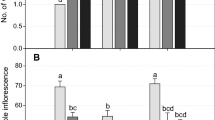Abstract
The ontogenetic change taking place in the facultative photoperiodic response of A. retroflexus to inductive short-day (SD) conditions was studied by exposing plants to continuous induction after different initial exposures to long-days (LD), and comparing the kinetics of their developmental responses (cumulative number of plants with reproductive apices, flowering stage, and height of the apical dome). As the plants progressed from emergence to “autonomous” flowering (i.e., in non-inductive conditions), their response to continuous induction became progressively more rapid. Reproductive development was initiated following a progressively shorter lag-phase after the start of induction, but its subsequent rate remained unchanged. Until the onset of reproductive development, the undifferentiated upper part of the shoot apex (apical dome) elongated much more rapidly in SD than in LD. However, in both cases reproductive development was initiated when the apex had elongated to about the same extent, after which its elongation accelerated considerably, but to similar rates in both photoperiods. The data indicate that progress towards reproductive development takes place in inductive (SD), as well as in non-inductive (LD) photoperiods, but one cycle of the latter is as effective as 0.20–0.25 of a cycle of the former. —Plants induced at different stages in ontogeny started to change their subsequent branching pattern (ratio of leafy to leafless branches) as soon as induction was delayed beyond “autonomous” flowering.
Similar content being viewed by others
Abbreviations
- LD:
-
long-days
- SD:
-
short-days
- RGR:
-
Relative Growth Rate
References
Lang, A.: Physiology of flower initiation. In: Encyclopedia of plant physiology, vol. XV, pt. 2, pp. 1380–1536, Ruhland, W., ed. Berlin-Heidelberg-New York: Springer 1965
Nougarède, A. Gifford, E.M., Rondet, P.: Cytohistological studies of the apical meristem of Amaranthus retroflexus under various photoperiodic regimes. Bot. Gaz. 126, 281–298 (1965)
Salisbury, F.B.: The flowering process. Oxford: Pergamon Press 1963
Vince-Prue, D.: Photoperiodism in plants. London: McGraw-Hill 1975
Went, F.W.: The experimental control of plant growth. Waltham, Mass., USA: Chron. Bot. 1957
Author information
Authors and Affiliations
Rights and permissions
About this article
Cite this article
Koller, D., Kigel, J. & Ovadiah, S. A kinetic analysis of the facultative photoperiodic response in Amaranthus retroflexus L.. Planta 136, 13–19 (1977). https://doi.org/10.1007/BF00387918
Received:
Accepted:
Issue Date:
DOI: https://doi.org/10.1007/BF00387918




